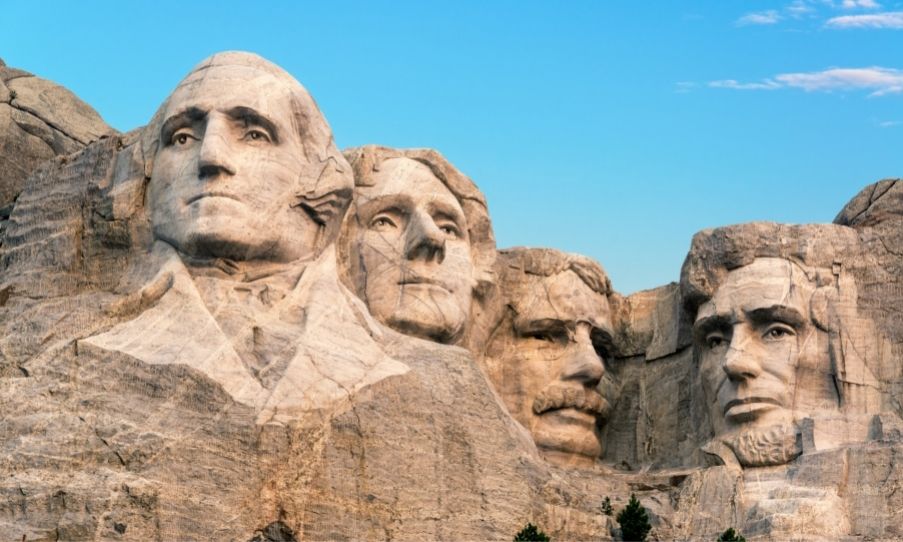
America has a long and storied history. Remnants of our nation's past can be found all across the country, from the first permanent English settlement in Virginia to one of our most famous natural wonders in California. Here are 10 places to visit to learn about American history and grow your admiration for this incredible country.
Arlington National Cemetery (Arlington County, Virginia)
Cemeteries are solemn. They're not usually a place people visit during vacations or road trips. But Arlington National Cemetery in Arlington, Virginia, is an intrinsic piece of American history and a sacred monument that anyone who’s interested in American history or is a staunch supporter of the military should visit.
This graveyard contains the graves of over 400,000 brave soldiers that fought in WWI, WWII, and the Korean War. It's also where John F. Kennedy, William Howard Taft, and the crew of the space shuttle Challenger were laid to rest. The Tomb of the Unknown Soldier, which is the final resting place of unknown soldiers from the aforementioned wars, is a necessary destination for anyone who wants to pay respect to our nation's fallen warriors.
Boston Tea Party Ships & Museum (Boston, Massachusetts)
There's a lot for history enthusiasts to do and see in Boston, Massachusetts. Anyone who finds themselves in the Bay State should stop by the Boston Tea Party Ships & Museum and take part in their revolutionary reenactments.
The Boston Tea Party Ships & Museum was built to educate the public on the events that led up to the American Revolution. It’s best known for its reenactments, where visitors can attend a colonial town meeting and even dump tea into the harbor. The museum's real pride and joy, however, is the Robinson Tea Chest, which is the sole remaining tea chest from the Boston Tea Party.
Ford's Theatre (Washington, D.C.)
Ford's Theatre in Washington D.C. is the site of one of America's most devastating tragedies—the assassination of Abraham Lincoln. There’s a museum inside the theatre that contains artifacts from the assassination, including the dagger and Philadelphia Deringer pistol used by John Wilkes Booth during the attack. The museum also expounds on the impact Lincoln's untimely death had on the nation. And for those that love the arts, the stage at Ford’s Theatre is still used for live performances.
Freedom Trail (Boston, Massachusetts)
The Freedom Trail is another interesting place in Boston, Massachusetts, that every history buff should see. The trail guides curious visitors to a number of historical buildings and monuments, including the Old South Meeting House, the Old State House, Faneuil Hall (also known as "The Cradle of Liberty"), and the Granary Burying Grounds, where Samuel Adams, Paul Revere, and other notable figures in American history are buried.
Jamestown (Williamsburg, Virginia)
The next place to visit to learn about American history is the Jamesburg Settlement in Williamsburg, Virginia. American history didn't start with the Declaration of Independence. Rather, it started with Jamestown, the home of the earliest English colonists.
Most of the original Jamestown was destroyed during Bacon's Rebellion in 1676, but a modern reconstruction was built in its place. You can visit the Jamestown Settlement Museum to see recreations of old ships and buildings and experience a day in the life of a settler.
Minute Man National Historical Park (Concord, Lincoln, and Lexington, Massachusetts)
In Middlesex Country, Massachusetts, you'll find Minute Man National Historical Park. This park was built to commemorate the Battles of Lexington and Concord, which marked the beginning of the American Revolutionary War. It includes a memorial, a monument dedicated to Paul Revere, and several restored buildings, including the Captain William Smith House, the Hartwell Tavern, the Wayside, and Barret’s Farm.
Mount Rushmore (Keystone, South Dakota)
There's nothing that's more simultaneously relaxing and invigorating than embarking on a leisurely hike through the picturesque Black Hills and... wait. Is that George Washington? Mount Rushmore, also known as the Shrine of Democracy, is a famous tourist destination in the Midwest. Just over two million people travel to Keystone, South Dakota each year to admire Gutzon Borglum's impeccable sculpture of Presidents George Washington, Thomas Jefferson, Theodore Roosevelt, and Abraham Lincoln.
Why visit Mount Rushmore? I mean, where else are you going to see a bunch of ginormous heads carved into a mountainside? Mount Rushmore was designed to bring more tourists to South Dakota, and it doubtlessly succeeded.
National Museum of American History (Washington D.C.)
If you want to learn about American history, it only makes sense to visit the National Museum of American History. The National Museum of American History: Kenneth E. Behring Center, originally named the Museum of History and Technology, features everything from the bona fide Star-Spangled Banner flag to a spectacularly detailed exhibit on the history of American lunchboxes. Whether you're interested in the history of the American military, American transportation and technology, or American art, this museum has something for everyone.
The Independence Hall and Liberty Bell Center (Philadelphia, Pennsylvania)
These two historical locations are located just across the street from each other. The Independence Hall was the place where the Second Continental Congress debated and adopted the Declaration of Independence and the United States Constitution. It's also where the Liberty Bell, a prominent symbol of the abolitionists, originally hung. Today, you can find the original Liberty Bell, crack and all, encased in a glass chamber in front of the Liberty Bell Center.
Yosemite National Park (California)
Yosemite might not be America's first national park, but without Yosemite, national parks wouldn't exist at all. On June 30, 1864, President Abraham Lincoln signed the Yosemite Land Grant, which protected Mariposa Grove and Yosemite Valley from commercial development.
Not long afterward, Ulysses S. Grant signed the Yellowstone National Park Protection Act to make Yellowstone America's first national park. Yosemite received national park status in 1890, eighteen years after Yellowstone. Yosemite is a testament to America's natural beauty and how dedicated Americans are to protecting and preserving their country’s future.
Don't forget to pack comfortable and patriotic clothing for your next cross-country adventure! Greater Half has clothes and accessories that are perfect for those who want to showcase their unwavering patriotism. Come and shop with us today for men and women's fashion that pays homage to our Red, White, and Blue!






